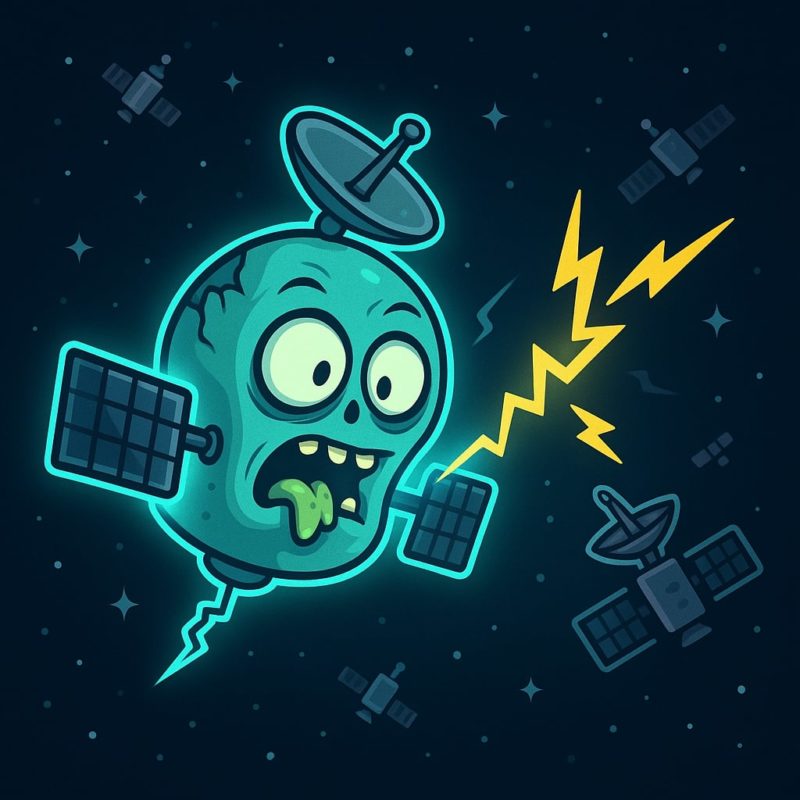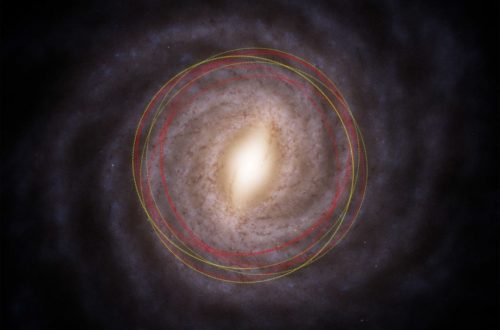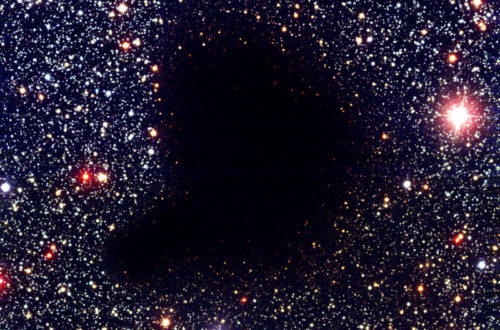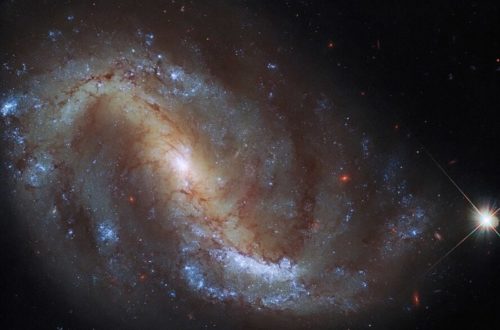Zombie Satellites: Risks, Impacts, and Mitigation Strategies

A zombie satellite is a dead or lost but still functioning satellite. Often in graveyard orbits or adrift in geostationary slots, these zombie satellites have the potential to switch on out of the blue as a result of residual power or software faults. They emit signals, potentially causing interference to active satellites and ground stations, increasing spectrum and collision risks. To provide context, we broadly describe how they happen, known instances, how to detect them, mitigation strategies, and what operators monitor today.
Defining Zombie Satellites
Zombie satellites, also known as defunct satellites, are dead satellites that briefly come back to life. Unlike communications satellites in orbit that perform scheduled broadcasts and obey ground commands, these satellites act randomly. A couple, such as NASA’s Relay-2, may glow with potent radio bursts decades later. They contribute to the space junk issue and can confuse astronomers hunting for dim celestial objects.
The Anomaly
Relay-2, retired for decades in medium Earth orbit, emitted a glint, a broadband pulse observed while surveying the skies. The signal was high signal-to-noise and fast rising, more like a transient than a constant carrier.
Teams initially identified it as a potential fast radio burst from deep beyond the Milky Way. Its time profile and spectral sweep matched certain FRB search filters, so it made it past early triage.
While dead-satellite radiation like this is not common, it’s a high-impact occurrence. They can masquerade as astrophysical transients and evade pipelines constructed for millisecond bursts.
That drives radio astronomy and spectrum monitoring to implement additional near-Earth veto steps, improved ephemeris cross-matching, and real-time direction-of-arrival checks to exclude orbital sources.
The Difference
Operational satellites transmit engineered carriers, telemetry frames, and beacon tones at specific frequencies and powers. Zombie satellites dump unscheduled bursts, bogus harmonics, or random carriers with no timing discipline.
Key gaps are zero ground contact, no station-keeping or mission plan, and no valid TLE updates for precise pointing. They’re flying blind and broadcasting accidentally.
These rogue signals can desense ground stations, increase noise floors, and contaminate protected bands. Radio telescopes could mistakenly mark false transients and squander follow-up minutes.
Common problems are blown transponders, deep battery fade, jammed power regulators, or warped antennas. Functioning spacecraft get updates for patching and frequency control. Zombies don’t.
The Cause
Triggers range from electrostatic discharge jumping across ancient dielectrics to micrometeorite strikes that short-circuit or arouse latched hardware.
Slow charging from solar wind and plasma can accumulate potential until a sudden dump flares a transmitter chain.
Material creep, tin whiskers, cracked solder joints and EEPROM bit rot can switch-flip and resurrect dead RF traces.
Strikes from debris on outside equipment can jolt power rails, close relays, or detune filters, producing short, strong blasts.
Famous Phantoms
Zombie satellites are decommissioned craft that still beacon or rouse sporadically, scrambling scans while enlightening us about legacy tech, cosmic climate, and frequency cleanliness. Backwards compatibility is often the culprit, especially early communications platforms and military testbeds, with signals that reverberate from decades-old design decisions and fault modes.
| Satellite | Launch year | Notable reactivation or odd event |
|---|---|---|
| LES-1 | 1965 | Carrier and pulsed signal reappeared after decades, found by amateurs |
| Relay 2 | 1964 | Sub-30 ns radio burst detected ~60 years post-mission by ASKAP |
| Transit 5B-5 | 1965 | Still in polar orbit; uncontrolled but intermittently heard |
| AMSAT-OSCAR 7 | 1974 | Heard again in 2002 after 1981 battery failure |
| Galaxy 15 | 2005 | Lost control in 2010, regained in 2011 after drift |
| IMAGE | 2000 | Rediscovered in 2018 by Scott Tilley after 2005 loss |
They’re important because early comsats and nav craft established early baseline architectures for connections, antennas, and power. Their unexpected outbursts have fooled ephemeral hunts but helped polish cull and RFI screening.
The LES-1 Signal
Hams caught LES-1 years after it was presumed defunct—an amazing surprise for something so ancient and lost to control. Their logs, transmitted over world-wide-webs, enabled triangulation and pattern audits.
Its transmitter probably reanimated when a busted regulator or wiring glitch allowed solar arrays to back-bias the RF chain. Thermal cycles and aging components can shift bias points enough to illuminate a carrier without instruction.
Monitors detected a naked carrier with irregular pulses. The drift and keying had no valid telemetry framing that stoked confusion until several stations corroborated Doppler and timing.
Amateurs continue to be essential. They span broad swaths, detect anomalies quickly, and maintain public databases that experts can tap.
The Radio Burst
Relay 2, launched in 1964, generated a radio pulse less than 30 nanoseconds sometime around sixty years after it ceased functioning. ASKAP in Western Australia snatched it up while looking for FRBs, which just goes to show how deep transient pipelines go these days.
For a second, it eclipsed the rest of the sky. That fooled early classifiers optimized for cosmic FRBs and highlighted how difficult it is to differentiate synthetic from astrophysical hits.
Follow up checks attributed it to the dead NASA satellite, not a cosmic source. The catalyst was probably an electrostatic discharge or a micrometeorite, both feasible in Earth orbit.
Transit 5B-5 continues to circle in a steady polar orbit. Some others incinerate, with heat in the atmosphere closing the matter.
Orbital Hazards
Uncontrolled zombie satellites, including defunct satellites, drift and transmit unguided, compounding hazards in congested satellite communications.
Collision Risk
Dead craft cannot do collision avoidance burns. Conjunction screening helps operators dodge, but zombies do not participate in cooperative maneuver planning.
A glancing hit at 10 km/s in LEO can shed thousands of shards. Each shard is its own bullet. Even paint chips can puncture radiators or star trackers.
Danger is greatest where the satellite traffic is thickest. Orbital Hazards In LEO, 500 to 1,200 kilometers sun-sync bands house Earth observation flotillas. In GEO, libration zones around plus or minus 75 degrees and plus or minus 105 degrees longitude pile up derelicts by graveyard thresholds. Better tracking is essential.
Spectrum Interference
Unstable buses can radiate out-of-band or spurious carriers as power systems and oscillators drift. Tumbling antennas project beams across neighbors.
These emissions can blind TT&C uplinks, corrupt telemetry downlinks, or desensitize GEO transponders that carry broadcast and broadband traffic.
Attribution is difficult because carrier drift, duty cycles, and intermittent activating depend on temperature and spin state. Identifiers are frequently absent.
Tracking The Ghosts
Detecting and tracking zombie satellites is crucial for ensuring satellite communications infrastructure, as it involves collision risk, spectrum hygiene, and transparency. Orbits are strewn with silent craft that may arise without notice, float adrift, or broadcast unfiltered carriers jamming neighboring satellites. The stakes cover low Earth orbit, medium Earth orbit, and geostationary orbit, where just a few meters per second drift can snowball into collisions.
Detection Methods
Ground radars cue on non-cooperative targets to get range, range rate, and radar cross-section. Radio telescopes and wideband SDR arrays search for unexpected carriers.
Specialized monitors assist in capturing short bursts and nanosecond pulses with coherent phalanxes, rapid FFT pipelines, and time-synced GPSDO receivers.
Predictive AI
Machine learning is leveraged to predict reactivation, carrier onset, and drift, trained on past ephemerides, thermal models, power telemetry proxies, and solar data.
Combining AI with radar, optical, and radio pipelines is useful to flag anomalies in real-time, focusing on high-risk passes and conjunctions.
Failure chains can also be modeled: battery shorts, attitude loss, thermal-induced latch-ups. AI can even guess windows when sunlight can reboot buses.
Cosmic Law
Zombie satellites test rules designed for a less crowded, less speedy orbital age. Liability, control, and due diligence become fuzzy once a spacecraft loses attitude control or contact. The Outer Space Treaty and Liability Convention make launching states responsible but under-specify fault when a dead satellite slips, fragments, radiates, or crashes years later. There’s no obvious mechanism for sharing expenses among multi-tenant launches, subcontractors, and operators.
Global Policy
To ensure a sustainable future for satellite communications, it is crucial to harmonize national end-of-life rules so operators face the same standards globally. This includes the passivation of energy sources, rapid deorbit in low Earth orbit, and controlled relocation to a satellite graveyard above geostationary orbit by at least 300 kilometers. By enforcing these standards, we can significantly reduce the risks associated with defunct satellites.
Furthermore, enforcing deorbit or graveyard relocation for GEO communications satellites can be supported by fuel-reserve margins and autonomous disposal modes. Conditional licensing and spectrum access can help enforce these regulations, with audits conducted at the launch and end of life.
Lastly, requiring transparent failure and anomaly reports within fixed timelines will improve accountability. This includes documenting attitude loss and power faults in an open database, which can aid conjunction assessment and legal traceability for satellite communications infrastructure.
Insurance Impact
Zombie satellites add tail risk and model error, so underwriters charge bigger premiums and greater deductibles. Pricing accounts for tracking uncertainty, tumbling, and increased collision likelihood.
Most policies now require proof of disposal plans, delta-v budgets, passivation proof, and autonomous safe modes. Without them, coverage shrinks or omits third-party liability.
Future Exorcisms
Zombie satellites can be domesticated or decommissioned through a combination of on-orbit servicing, responsible disposal, and more intelligent design from the beginning.
Northrop Grumman’s MEV‑1 and MEV‑2 have extended the life of communications satellites by five years by grappling GEO commsats through the liquid apogee engine nozzle. Following that, mission extension pods (MEP) offer smaller, more affordable “bolt-on” propulsion and attitude control for satellite communications.
High‑power electric tugs with Hall thrusters could transport dead payloads to satellite graveyards or recycling depots, paving the way for future advancements in the satellite communications infrastructure.
Key gaps include the need for autonomous rendezvous and proximity operations with non-cooperative, tumbling targets, as well as standard grapple fixtures. Additionally, fault-tolerant guidance, navigation, and control under poor lighting are critical for the success of the lincoln experimental satellite program. Needed demonstrations involve refueling geostationary buses via xenon or hydrazine valves, swapping reaction wheels or star trackers, and attaching deorbit kits for low Earth orbit craft, ensuring controlled reentry to minimize casualty risks.
Conclusion
For the record, zombie satellites are no urban legend. Dead stuff can arise and float. Others transmit noise. Some present danger. On the ground, crews pursue patches. Radar nets eye the heavens. Space law still trails. Cleanup tech looks promising, like grapples, tethers, and drag sails. Costs remain expensive. Timelines remain tight.
Real wins will require transparent guidelines and information sharing. Companies can include fail-safe modes. Constructors may architect secure final states.
Got a take or a use case? Leave a comment.
Frequently Asked Questions
What is a “zombie satellite”?
A zombie satellite, often referred to as a defunct satellite, is one that’s lost control or contact but continues to transmit or linger in orbit. It could turn on erratically, jam transmissions, or simply become junk, posing risks to neighboring satellites.
Which zombie satellites are the most famous?
Galaxy 15 (2010) and the Lincoln experimental satellite LES-1 (brought back to life in 2013). These communication satellites shocked operators by transmitting uncontrolled, enhancing procedures for anomaly response and situational awareness.
Why are zombie satellites dangerous?
Rogue orbits and broken transmitters from defunct satellites threaten to impact communications networks and navigation services, while operators have avoidance and frequency protection planned for satellite communications.
How do experts track zombie satellites?
Agencies and observatories use radar, optical telescopes, and radio measurements for satellite communications. They refresh orbital elements and disseminate information via catalogs, enabling collision avoidance and spectrum management.
Who is responsible under space law?
Launching states are responsible under the OST and the Liability Convention, particularly regarding the management of satellite communications infrastructure. Operators must resolve debris and coordinate frequencies through the ITU to ensure effective communication satellite needs.
Can zombie satellites be repaired or removed?
Every so often, this might be a controlled re-entry, a satellite graveyard maneuver, or an active debris removal mission involving tugs, harpoons, or nets. Refueling and servicing satellite communications are nascent but challenging and expensive.
Would you like to receive similar articles by email?





